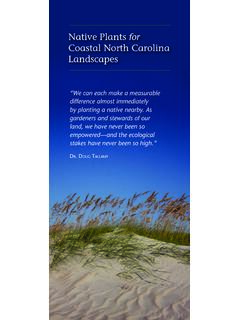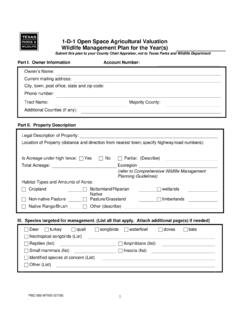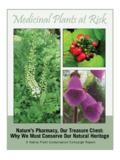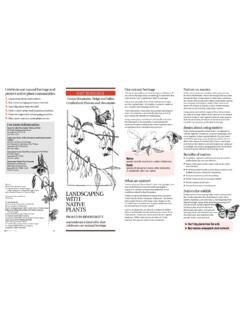Transcription of Establishing Native Grasses - USDA
1 Establishing Native Grasses Conservation Reserve Program Job Sheet CP2 INTRODUCTION Native Grasses include both cool-season and warm-season Grasses . Cool-season Grasses grow best in the spring and fall when soil and air temperatures are cooler. Warm-season Grasses grow best during the warmest months of the year, typically from June through early September. Native cool-season Grasses are an excellent option when shorter Native Grasses are desired. Native cool-season Grasses provide more wildlife value than introduced cool-season Grasses . Wildryes are the most common Native cool-season Grasses sown in Pennsylvania.
2 Bluestems, Indiangrass, and switchgrass are the most common Native warm-season Grasses sown in Pennsylvania. Many warm-season Grasses are deep rooted, long-lived perennials with considerable tolerance to relatively low pH, low fertility, and drought. Native Grasses , either alone or in combination with Native forbs or wildflowers, can be planted to reduce soil erosion and sedimentation, improve water quality, and provide wildlife habitat . Stiff-stemmed Native warm-season Grasses can serve as a barrier to erosion and can trap sediment carried by water and wind.
3 Native Grasses with a bunch-type growth form provide excellent nesting and protective habitat for many species of birds, as well as a source of seeds and insects. Native Grasses can play an important role in conservation and agricultural production. However, establishment and maintenance requirements are significant and should be considered. First-time users of Native Grasses must pay special attention to the details of managing these Grasses while they are becoming established (mowing, weed control, etc.). Once established, mature stands may pose a fire hazard.
4 Firebreaks of introduced cool-season Grasses should be established and maintained around buildings, woodlands, etc. This job sheet provides instructions for planting and maintaining Native Grasses so they can serve their intended purpose. Using proper planting and management techniques, especially during the establishment years, will significantly improve plant health, reduce weed problems, and increase the likelihood of success. SITE PREPARATION Before planting, it is essential to reduce competition from other vegetation that may be present, such as other Grasses or broadleaved weeds.
5 Native grass seedlings are slower to establish, and can be easily out-competed in the spring by faster growing introduced cool-season Grasses and many broadleaved weeds. The type and density of the existing vegetation will determine how much pre-planting control is needed. It's important to allow adequate time to complete this process. If significant quantities of noxious or aggressive weeds or invasive plants are present, be aware that you may need a year or more to control them before you can plant, especially if you will be planting a large area. Sites without Existing Vegetation If Native Grasses will be planted into a clean, relatively weed-free area (such as cropland that was planted during the previous growing season), then competition from existing vegetation should not be a concern.
6 However, a cover crop may be needed for erosion control and/or to reduce future weed competition (see page 3). Take into account any noxious or aggressive weeds on the site that have been suppressed (but not killed) with previous herbicide applications. If live root systems are present, these weeds may be very difficult to kill in a new planting without destroying the desirable plants. If you think you have a significant weed problem, it may be prudent to plant a temporary PA CRP Job Sheet Establishing Native Grasse (CP2) March 2011 Page 1 of 4 cover crop such as spring oats and use an appropriate herbicide to treat weeds for one full growing season.
7 Then plant the Native Grasses the following year. Sites with Existing Vegetation If Native Grasses are going to be planted into existing vegetation such as other Grasses or broadleaved weeds, you will need to reduce competition before planting. For sites that need extensive preparation, much of the work can be done during the fall prior to spring planting, or in late spring before a fall planting. Mow the field or planting site and treat the area with herbicide to reduce competition. Using herbicides. Choose a non-selective herbicide such as glyphosate. A selective herbicide such as 2,4-D may be used instead, if you only need to control broadleaved weeds.
8 Follow all label directions when using herbicides, and consider herbicide persistence(carryover) as it may affect new plantings. For extremely vigorous turf or weeds, you should plan to make one application of herbicide in early fall, followed by another the next spring before planting. Do not plant the Native Grasses until the competing vegetation is sufficiently controlled. It is much easier to control the competition before planting than afterward. Using cultivation only. If you do not want to use herbicides, then you will need to cultivate the field or planting site.
9 Cultivation is usually less effective than herbicides for killing heavy sod or persistent weeds. Also, bare ground produced by cultivation may be subject to erosion and can provide a good seedbed for more weed growth. If necessary, use a cover crop (see page 3) to control erosion and help suppress weeds. Herbicide Carryover Carryover from herbicide treatments in prior years can pose a threat to new plantings. Seedlings are particularly sensitive to herbicide carryover. Herbicides such as glyphosate have very short persistence and generally do not pose a risk for carryover.
10 Herbicides such as atrazine have medium to long persistence and can pose a risk of carryover. The persistence of herbicides is directly affected by factors such as soil pH and moisture. To assess risks before planting, read the herbicide label or contact the manufacturer for specific information on persistence. PLANTING Planting Dates Recommended planting dates for Native cool-season Grasses typically range from late winter to late spring, and late summer to mid-fall. Summer heat and the lack of moisture is very stressful for Native cool-season Grasses . Their survival is dependent on a well-developed root system.
















